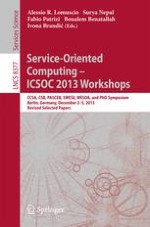This book constitutes the revised selected papers of the workshops of the 11th International Conference on Service-Oriented Computing (ICSOC 2013), held in Berlin, Germany, in December 2013. The conference hosted the following five workshops: 3rd International Workshop on Cloud Computing and Scientific Applications (CCSA'13); 1st International Workshop on Cloud Service Brokerage (CSB'13); 1st International Workshop on Pervasive Analytical Service Clouds for the Enterprise and Beyond (PASCEB'13); 9th International Workshop on Semantic Web Enabled Software Engineering (SWESE'13); 9th International Workshop on Engineering Service-Oriented Applications (WESOA'13); and a PhD Symposium, with best papers also being included in this book. The 54 papers included in this volume were carefully reviewed and selected from numerous submissions. They address various topics in the service-oriented computing domain and its emerging applications.
